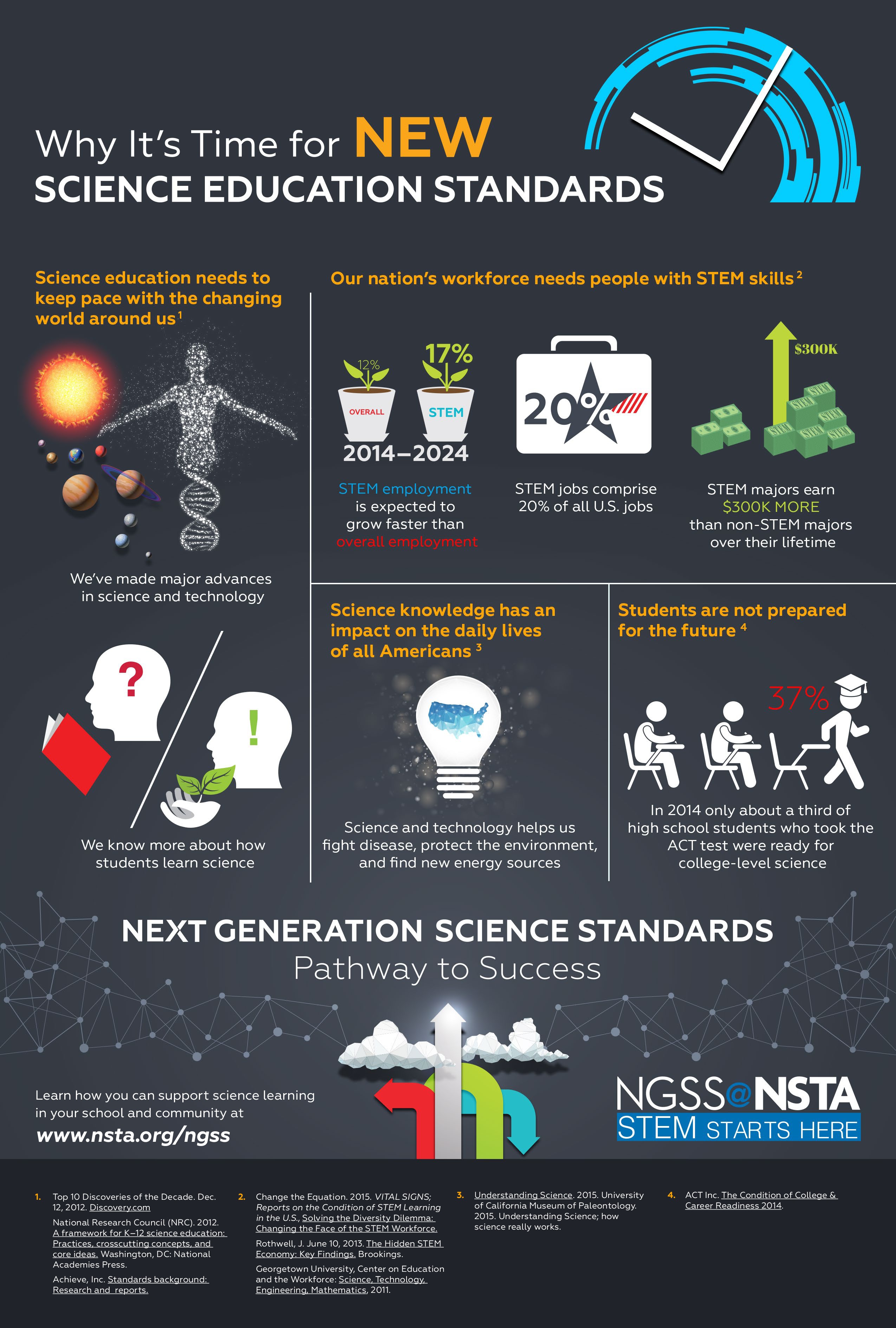New NSTA Infographic on NGSS Now Available for Download
By Cindy Workosky
Posted on 2016-03-07
Did you know that from 2014 to 2024 employment in STEM subjects (science, technology, engineering, and mathematics) is expected to grow faster than overall employment? In fact, STEM jobs now comprise 20% of all U.S jobs. But, are students ready for the STEM world? In 2014, only about a third of high school students who took the ACT test were ready for college-level science.
These statistics, and more, can be found in the first of a series of visual and informative infographics from NSTA on the Next Generation Science Standards (NGSS). Find it now on the NGSS@NSTA Hub. NSTA is launching the series as a way to support teachers, schools and district leaders, parents, business leaders, and other stakeholders, as they transition to a new way of teaching and learning science. Seventeen states, the District of Columbia, and numerous districts around the country have already adopted the NGSS and are making steady progress on building awareness of the standards, helping teachers understand the changes needed in classroom instruction, identifying and developing classroom materials, mapping out curricula, and more. NSTA’s position statement on the NGSS outlines our recommendations for full implementation.
Central to this important transition is a constant reminder of the need for and reasons why science educators choose this path, which is why we focused our first infographic on the topic, “Why It’s Time for NEW Science Education Standards.”
Here are some reasons.
Science education needs to keep pace with the changing world around us. We’ve made major advances in science and technology—consider the discoveries in space science resulting with the demotion of Pluto to a dwarf planet, or the advances we’ve made in mapping the human genome. Science is constantly changing and science teaching needs to keep pace.
We also know more about how students learn. Rather than focusing on memorization of lots of unrelated facts, research shows that engaging in the practices used by scientists and engineers plays a key role in student comprehension. The NGSS emphasizes a smaller number of core ideas that students can build on from grade to grade. The more manageable scope allows teachers to weave in practices and concepts common to all scientific disciplines — which better reflects the way students learn.
Our nation’s workforce needs people with STEM skills. Today’s modern workforce depends on individuals with scientific and technological skills. Study after study points to the changing workforce where skills and expertise in the STEM fields are essential, and also more profitable. Did you know that a person with a STEM major earns on average almost $300,000 more than non-STEM majors over their lifetime? And the employment outlook for STEM jobs well into the future is strong.
Science knowledge has an impact on the daily lives of all Americans. From health care to environmental stewardship, a countless number of personal and societal issues require citizens to make informed decisions based on their understanding of science and technology. Consider the current health crisis to contain and find a vaccine for the Zika virus disease. Most would agree that for our democratic society to continue—and for our economy to thrive—our citizens must be educated and scientifically literate. Even the majority of students who will not be scientists need to be informed consumers of the science that is changing daily.
Students are not prepared for the future. Only 37% of high school students who took the ACT test were ready for college-level science. In addition, www.nextgenscience.org lists the following statistics that all point to the need for strengthening science teaching and learning.
- The 2012 Program for International Student Assessment (PISA) ranks the United States as 23rd in Science, 30th in Math, and 20th in Reading Literacy out of 65 OECD education systems.
- In 2011, the United States ranked 23rd in high school graduation rate among OECD countries.
- Over a third of eighth-graders scored below basic on the 2011 NAEP Science assessment.
- In 2012, 54% of high school graduates did not meet the ACT’s college readiness benchmark levels in math, and 69% of graduates failed to meet the readiness benchmark levels in science.
Download NSTA’s infographic today and share it with your colleagues, principals, parents, and others. Stay posted for more infographics in the coming months that will focus on the architecture of the NGSS, support needed for implementation, and what parents can do to support their child’s learning at home.
The mission of NSTA is to promote excellence and innovation in science teaching and learning for all.
Future NSTA Conferences
2016 National Conference
2016 STEM Forum & Expo
2016 Area Conferences
Follow NSTA
Disclaimer: The views expressed in this blog post are those of the author(s) and do not necessarily reflect the official position of the National Science Teaching Association (NSTA).



